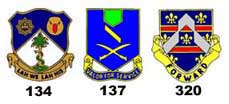 |
134th Infantry Regiment"All Hell Can't Stop Us" |
 |
 |
134th Infantry Regiment"All Hell Can't Stop Us" |
 |
Transcribed by Roberta V. Russo, Palatine, Illinois

The 35th Division is steeped in tradition. The spirit and meaning of its nickname, Santa Fe, is legendary. Many of the organizations that made up the division had their origins in the last century. A number of the units fought in the Indian Wars and helped to open the West. They also served in the Spanish-American War and were with Pershing in the punitive expedition against Mexico.
"That's my old outfit, the 35th!"
It may be in some solid Midwest town or New York's Grand Central Station, but it's the same story. A middle-aged fellow spots the Santa Fe shoulder patch and drifts over to find out what's happened to the division he served with in '17 - 18.
Likely he'll mention the distinctive blue and white patch and then hasten to add "I was with the 137th Infantry in the Argonne - a damn good outfit!" . . . or, "I went through last trip with the 110th Medics." For a moment there will be a pause, and his eyes seem to be far away, and you wonder if he's thinking of his old gang. If your memories could follow his, they'd probably see these things. Twelve months training endured in the dusty, weather-beaten hills around Camp Doniphan in southern Oklahoma. Then, along in spring of 1918 the 35th packed up and was sent overseas to England and France. Frontline training came next followed by move into quiet sectors in the Vosage Mountains under old III Corps or the French.
But the Armistice didn't happen until an affair, called the Meuse-Argonne operation, pushed Fritz back and threatened to cut his main supply artery at Metz . . . Every 35th veteran remembers the Argonne. . . .
The "old Outfit" was the right flank division of the First Corp of U. S. First Army. It had the job of shoving up a swampy, fog drenched valley - an open section flanked on one side by a forest and on the other by the Aire River and Argonne.
Starting conspicuously, the old 138th Infantry knocked the Germans off formidable Vauquois Hill. Fighting ahead for five days, the division was always even with the farthest advance of the whole army.
If he were an infantryman, our "vet" could remember his rations. That was easy - first day, cold field chow; second day, chow from abandoned German kits; third day, water, if lucky; fourth day, nothing; fifth day, nothing. But they fought on, to win.
If an artilleryman, or in any wheeled outfit, he'd never forget the mire he tugged his spokes through to support the advancing doughboys. They got hungry, too, but the third day they needed the chow-wagon nags to pull the guns, so they left the chow behind long enough to smack the German in his own "bread-basket."
If he were an engineer he'd probably think of September 29. . . .
Up front the Germans had hurled their heaviest counter-attacks of the whole front against the Santa Fe Infantry around Exermont.
The 35th had knocked out one enemy division the first two days, fought off and pushed back a Prussian Guard division the next two days, but now they were being hard-pressed by another fresh division, the German 52nd.
An eyewitness of the 35th's Artillery watched part of this scrap near Montrebeau Woods. He tells of hungry, shell-raked, paddle feet men fighting the Heines with nothing but their rifles and a few machine guns they'd taken from the Prussian Guards.
Well, the engineer remembers how he dug in along a strategic ridge, and, when hard pressed elements of the infantry came back, they stood fast, side by side there, and stopped the German Fifty-second cold. At one time 13 Hun batteries were delivering flanking fire into the 35th's positions.
Relieved by the First Division, 30 September, the Santa Fe rested a few days before going back into the line near Verdun to fight until the Armistice under French XVII Corps and U. S. Second Army.
| Return to Presenting the 35th Infantry Division in WWII table of contents |
| View My Guestbook |